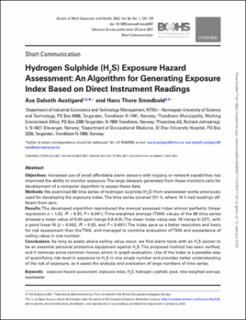| dc.contributor.author | Austigard, Åse Dalseth | |
| dc.contributor.author | Smedbold, Hans Thore | |
| dc.date.accessioned | 2022-03-09T11:42:57Z | |
| dc.date.available | 2022-03-09T11:42:57Z | |
| dc.date.created | 2021-07-26T18:44:49Z | |
| dc.date.issued | 2021 | |
| dc.identifier.citation | Annals of Work Exposures and Health. 2021, 66 (1), 124-129. | en_US |
| dc.identifier.issn | 2398-7308 | |
| dc.identifier.uri | https://hdl.handle.net/11250/2983994 | |
| dc.description.abstract | Objectives Increased use of small affordable alarm sensors with logging or network capabilities has improved the ability to monitor exposure. The large datasets generated from these monitors calls for development of a computer algorithm to assess these data. Methods We examined 88 time series of hydrogen sulphide (H2S) from wastewater works previously used for developing the exposure index. The time series covered 331 h, where 16 h had readings different from zero. Results The developed algorithm reproduced the manual assessed index almost perfectly (linear regression β = 1.02, R2 = 0.97, P < 0.001). Time-weighted average (TWA) values of the 88 time series showed a mean value of 0.04 ppm (range 0.0–0.9). The mean index value was 18 (range 0–337), with a good linear fit (β = 0.002, R2 = 0.93, and P < 0.001). The index gave us a better resolution and basis for risk assessment than the TWA, and managed to combine evaluation of TWA and exceedance of ceiling value in one number. Conclusions As long as peaks above ceiling value occur, we find alarm tools with an H2S sensor to be an essential personal protective equipment against H2S. The proposed method has been verified, and it removes some common human errors in graph evaluation. Use of the index is a possible way of quantifying risk level in exposure to H2S in one single number and provides better understanding of the risk of exposure, as it eases the analysis and evaluation of large numbers of time series. | en_US |
| dc.language.iso | eng | en_US |
| dc.publisher | Oxford University Press | en_US |
| dc.relation.uri | https://prosjektbanken.forskningsradet.no/project/FORISS/312504 | |
| dc.rights | Navngivelse 4.0 Internasjonal | * |
| dc.rights.uri | http://creativecommons.org/licenses/by/4.0/deed.no | * |
| dc.title | Hydrogen Sulphide (H2S) Exposure Hazard Assessment: An Algorithm for Generating Exposure Index Based on Direct Instrument Readings. Annals of Work Exposures and Health. | en_US |
| dc.type | Peer reviewed | en_US |
| dc.type | Journal article | en_US |
| dc.description.version | publishedVersion | en_US |
| dc.source.pagenumber | 124-129 | en_US |
| dc.source.volume | 66 | en_US |
| dc.source.journal | Annals of Work Exposures and Health | en_US |
| dc.source.issue | 1 | en_US |
| dc.identifier.doi | 10.1093/annweh/wxab047 | |
| dc.identifier.cristin | 1922711 | |
| dc.relation.project | Norges forskningsråd: 312504 | en_US |
| cristin.ispublished | true | |
| cristin.fulltext | original | |
| cristin.qualitycode | 1 | |

